One of the biggest challenges when running your BigCommerce store is keeping track of your products. Without proper control, you might oversell items or run out of stock too soon. This is why BigCommerce inventory management is an important aspect that you'll need to pay close attention to in your daily operation.
If you are wondering what BigCommerce stock management is and how it can help your business, this article is just for you. Keep scrolling for:
- Everything you need to know about eCommerce inventory management on BigCommerce
- BigCommerce inventory management features
- The benefits of inventory management BigCommerce
- How to add products for stock management
- Best BigCommerce inventory management systems
- Best practice for effective BigCommerce inventory management
Without further delay, let's get going!
What is BigCommerce Inventory Management
BigCommerce inventory management is the structured way of organizing, tracking, and controlling all the products listed in a BigCommerce store. It focuses on keeping accurate records of product details such as stock levels, SKUs, and variants so that every item is properly accounted for within the platform. This system ensures that store owners always know the exact quantity of each product available at any given time.
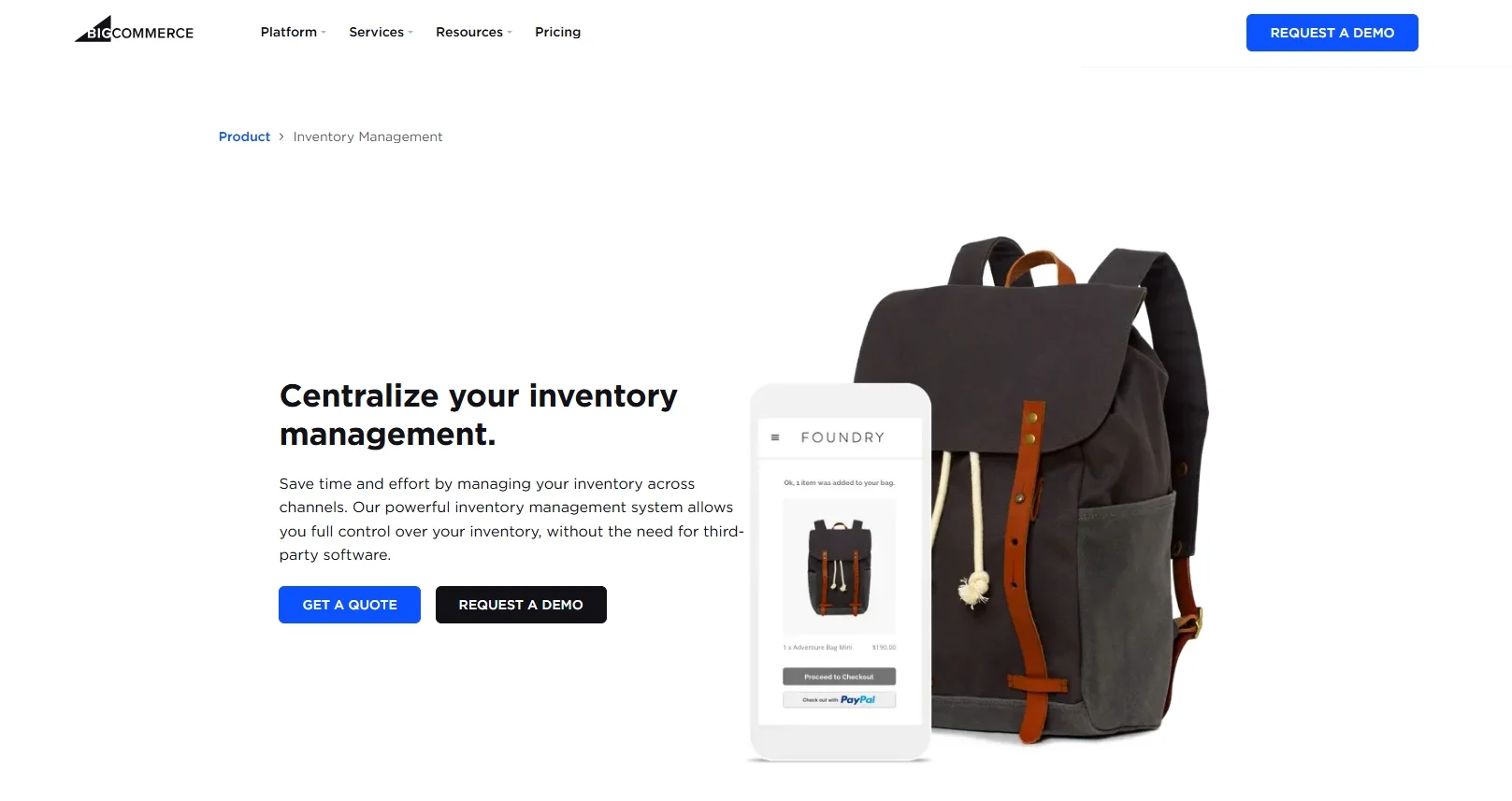
Within BigCommerce, inventory management starts when you create a product listing. Each product is assigned information like a SKU number, inventory tracking status, and stock quantity. The platform then monitors stock levels automatically whenever an order is placed. It also allows you to decide how the store behaves when inventory runs low, such as hiding out-of-stock products or allowing backorders.
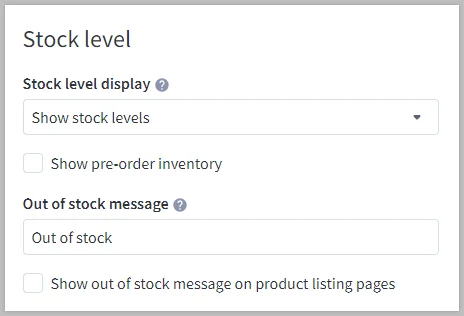
This management process can be handled manually for smaller catalogs or automated through integrations for larger product ranges. BigCommerce also supports bulk inventory updates using CSV files, which is helpful for stores with many items. For more advanced needs, the platform offers APIs that connect to third-party inventory tools and warehouse management systems, making it possible to coordinate stock across multiple channels.
In simple terms, BigCommerce inventory management is the foundation that keeps your product information organized inside the platform. It works as a system that tracks product movement, from the moment a product is added to the catalog to the point it is sold and shipped.
BigCommerce Inventory Management Features
There are several native BigCommerce features that help you manage your inventory with ease. These tools are built directly into the platform, so you can organize your stock, keep it updated, and ensure smooth order processing without extra effort. Here are the main features you will find in BigCommerce inventory management:
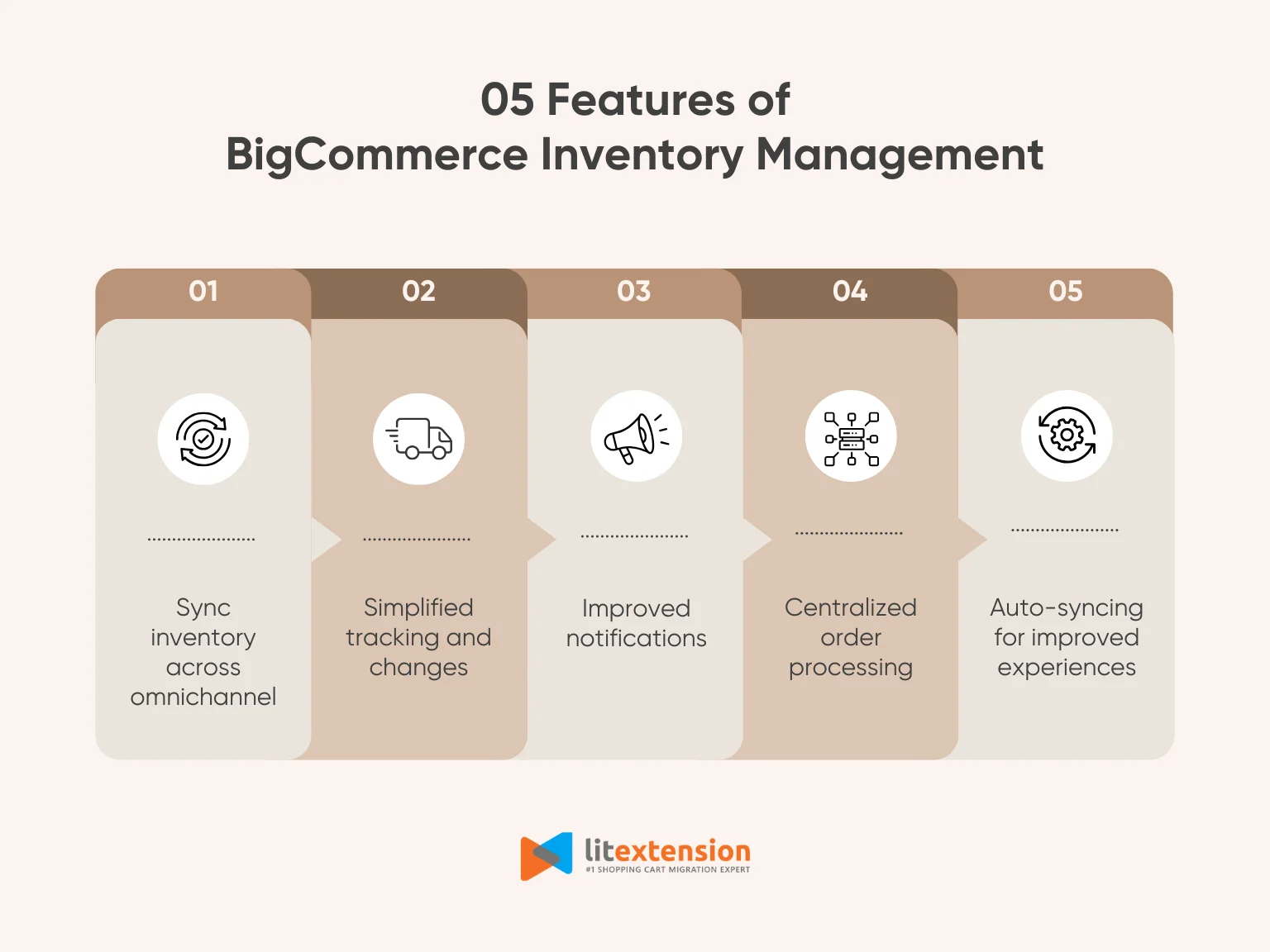
1. Sync inventory across omnichannel
BigCommerce makes it simple to sell on multiple channels while keeping your inventory accurate. You can connect your store to in-person sales through Square, online marketplaces like eBay and Amazon, or even social media platforms. The BigCommerce Channel Manager helps you link existing sales channels or add new ones in just a few steps, keeping your inventory synced everywhere.
2. Simplify tracking and changes
You can easily track inventory by product or SKU, so you always know how many items are available. When stock levels change, you can update them individually or use the bulk import/export tool to edit thousands of products at once. This makes it easier to maintain accurate inventory records, even if you have a large product catalog.
3. Improved notifications
BigCommerce allows you to set low-stock alerts so you know when it’s time to restock. You can also enable out-of-stock notifications for your customers, ensuring they stay informed. These alerts prevent unexpected stockouts and keep your storefront updated in real time.
4. Centralized order processing
With BigCommerce, you can manage all your orders from one central hub. This feature lets you process, fulfill, and track orders efficiently, no matter which sales channel they came from. It keeps everything organized so you don’t have to switch between multiple systems.
5. Auto-syncing for improved experience
The platform supports real-time, two-way syncing for inventory. Whenever a sale is made, your stock updates automatically, no matter where the order originated. This reduces the risk of overselling and avoids data entry mistakes that could frustrate customers.
Together, these features create a solid foundation for keeping your inventory accurate and well-organized within BigCommerce.
The Benefits of Inventory Management in BigCommerce
Managing inventory in BigCommerce brings several important advantages that help keep your store organized and efficient. By using the platform’s built-in tools, you can maintain better control over your products and improve how your business operates.
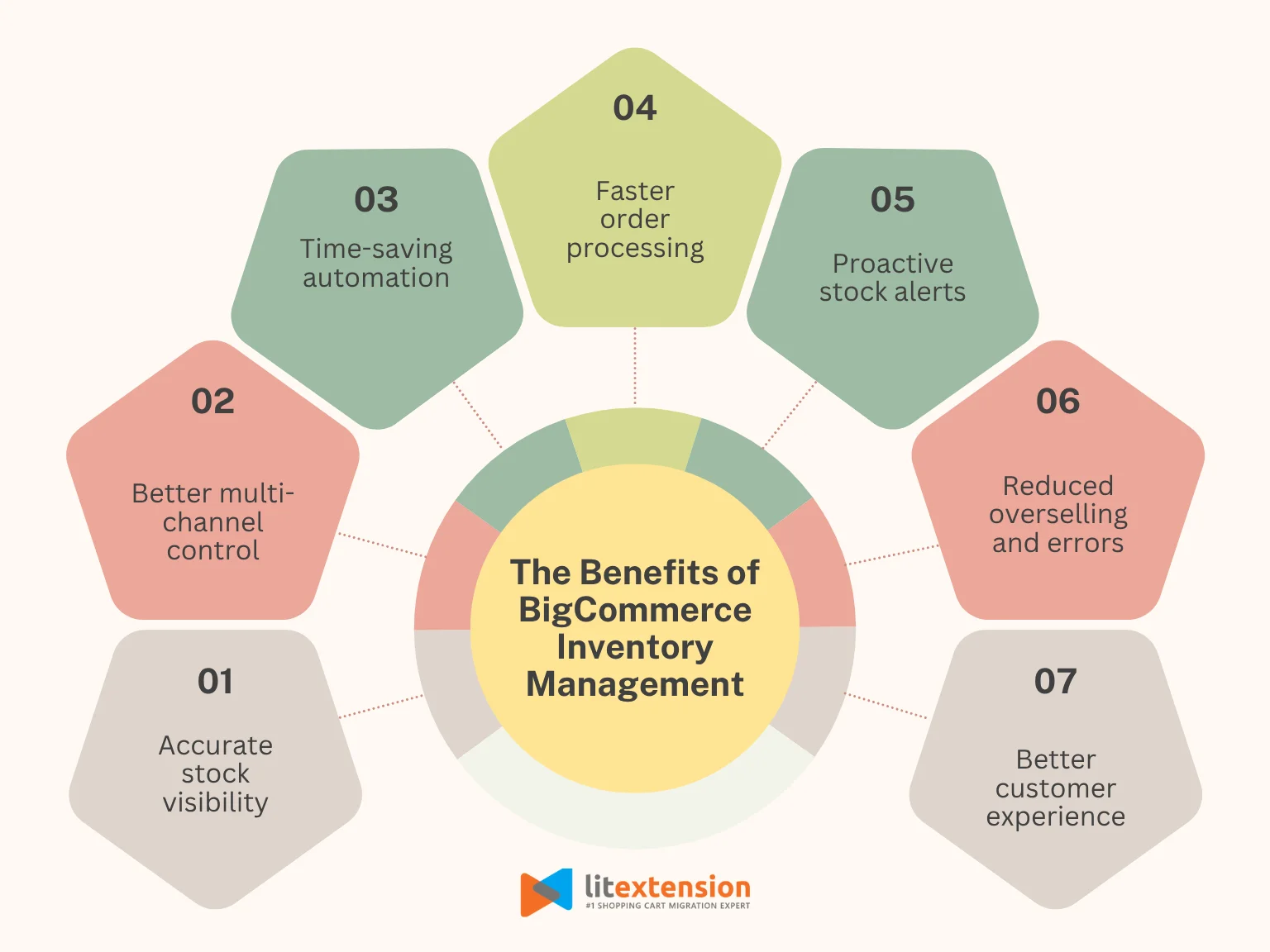
Here are the key benefits of using BigCommerce inventory management:
- Accurate stock visibility: You always know exactly how many items are available, which reduces confusion and helps you avoid selling products you don’t have in stock.
- Better multi-channel control: When you sell on multiple platforms like Amazon, eBay, or social media, BigCommerce keeps your stock synced across all channels. This ensures every sales channel shows the correct inventory levels.
- Time-saving automation: Automatic syncing and updates mean you don’t have to manually adjust stock levels after every sale. This saves time and reduces human error.
- Faster order processing: With centralized order management, you can fulfill and track all orders in one place. This makes your workflow simpler and more efficient.
- Proactive stock alert: Low-stock and out-of-stock notifications keep you informed before you run into problems. This allows you to reorder products on time and avoid lost sales.
- Reduced overselling and errors: Real-time updates prevent overselling by instantly adjusting stock levels when an order is placed. It also lowers the chances of mistakes caused by manual data entry.
- Better customer experience: Accurate inventory ensures customers see up-to-date product availability. This builds trust and improves their shopping experience.
By using these benefits together, BigCommerce inventory management helps you keep operations smooth and reliable as your store grows.
How to Add Products for Inventory Management in BigCommerce
Setting up products correctly is the first step to effective BigCommerce inventory management. When you add products to your BigCommerce store, it's important to configure inventory settings so the system can accurately track stock levels and update them in real time.
Here’s a step-by-step guide to help you add products with inventory tracking enabled:
1. From your BigCommerce admin dashboard, navigate to “Products” > “Add”. Then, fill in the required information such as Product Name, SKU, and Default Price.
2. After that, switch to the “Inventory” tab in the side navigation. Here, you'll need to enable the “Track inventory” option and fill in the current stock you have. You can also set up the “Low stock” alert to receive a notification that you are running low.
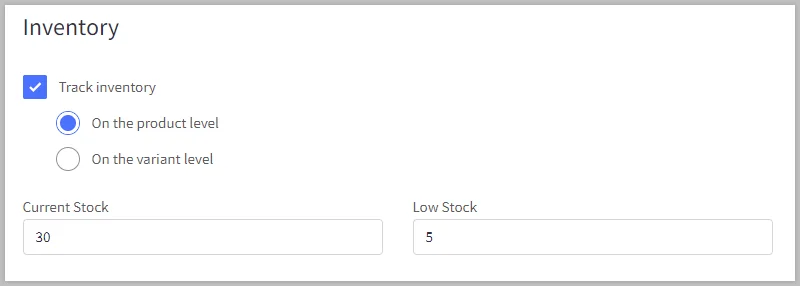
3. To update the stock level, simply edit in your product dashboard.
Best BigCommerce Inventory Management Software
While this platform comes with its own built-in BigCommerce inventory management tools, these features are best suited for basic tracking and small to mid-sized catalogs. As your business grows or your operations become more complex, especially if you sell on multiple channels or manage several warehouses, you may need more advanced capabilities than what the native system offers.
To help streamline workflows, automate processes, and gain better control over stock levels, many merchants turn to third-party inventory management software. These tools integrate directly with BigCommerce and offer features like real-time syncing, demand forecasting, multi-location tracking, and automated order routing.
Below are some of the best third-party inventory management solutions that work seamlessly with BigCommerce, each designed to meet different business needs.
#1 ConnectPOS
ConnectPOS is a robust point-of-sale (POS) system that integrates directly with BigCommerce, making it a top choice for businesses that operate both online and in physical retail environments. It enhances BigCommerce inventory management by keeping stock levels synchronized in real time across all channels, helping merchants avoid errors and improve operational efficiency.
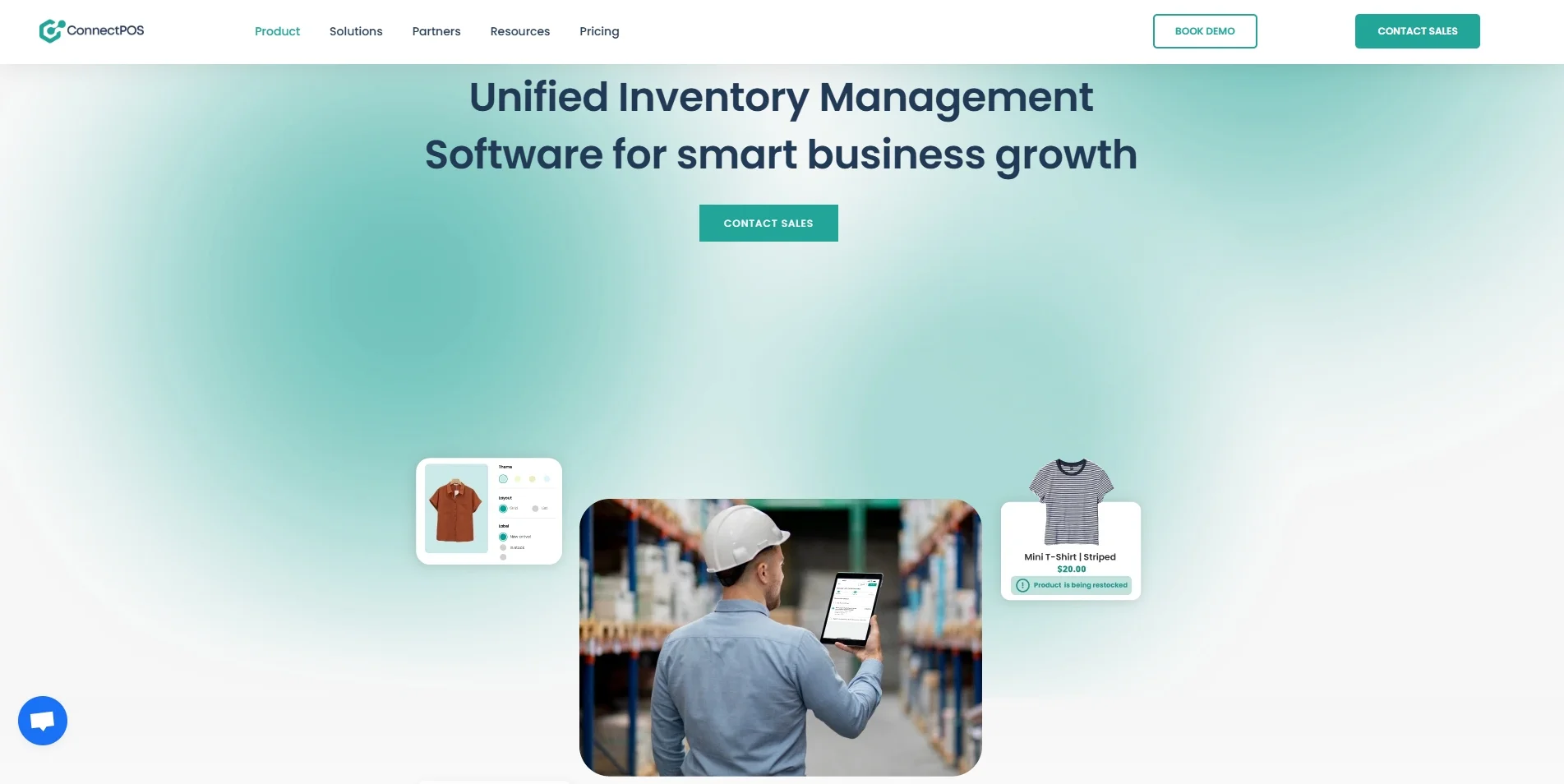
This solution is ideal for omnichannel retailers who want to unify their in-store and online inventory under one system. ConnectPOS is known for its user-friendly interface, flexible setup, and real-time data syncing, making it a reliable tool for growing businesses.
Key features that ConnectPOS offers:
- Real-time inventory sync between POS and BigCommerce
- Multi-store and multi-warehouse inventory management
- Barcode scanning support for fast product lookup
- Customizable POS interface for a better user experience
- Detailed inventory and sales reporting tools
Pricing: Custom based on your business
#2. Extensiv
Extensiv (formerly known as Skubana) is a comprehensive operations platform designed to unify inventory, orders, and fulfillment across multiple sales channels, including BigCommerce. It is especially well-suited for high-volume merchants who need advanced tools to manage complex supply chains and scale their operations efficiently.
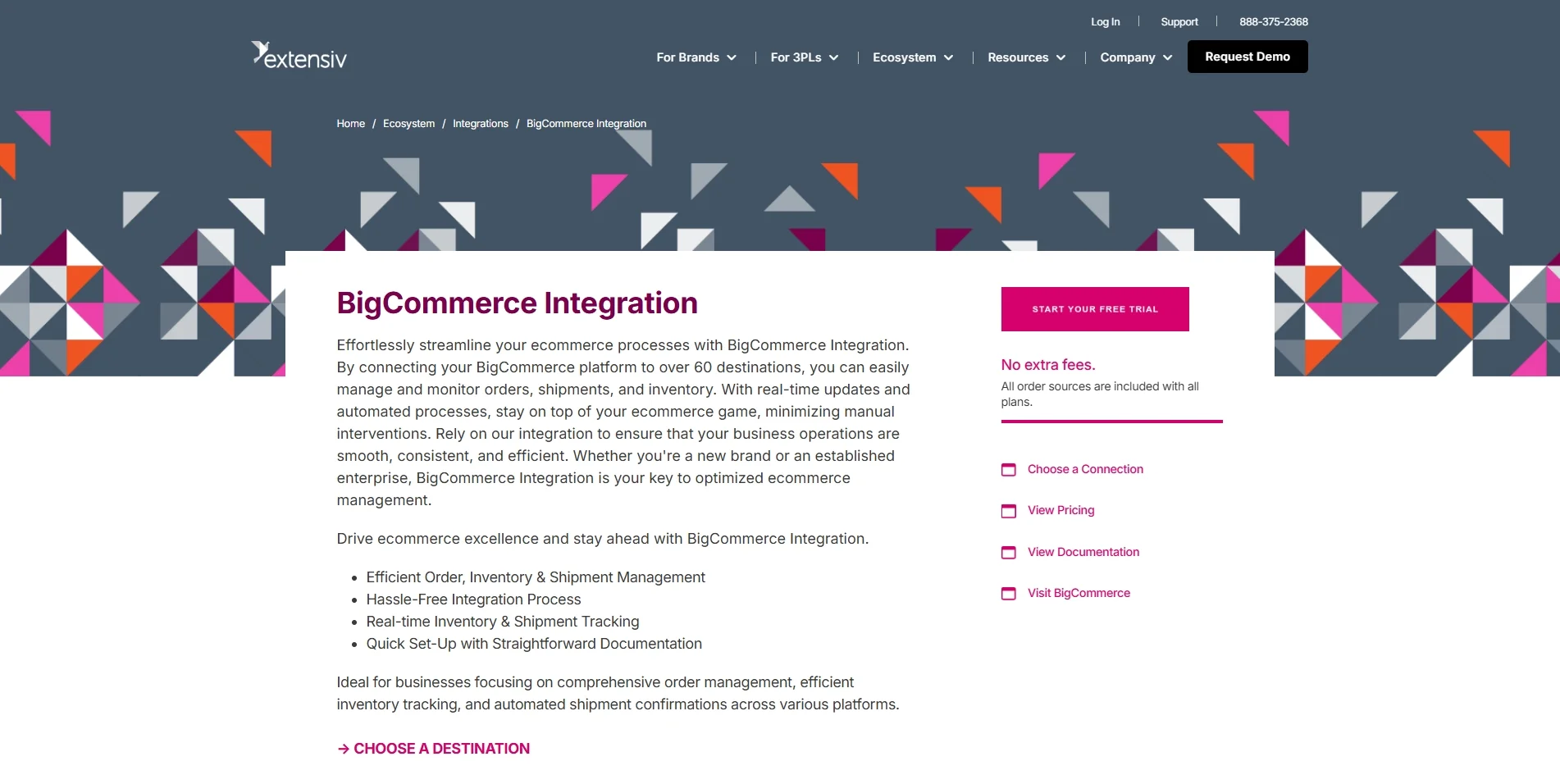
With its deep integration, Extensiv enhances BigCommerce inventory management by providing centralized visibility and control over inventory across warehouses, marketplaces, and retail platforms. This ensures that stock levels remain accurate everywhere, even during high-demand periods or across multiple fulfillment centers.
Key features that Extensiv offers:
- Centralized inventory control across all channels and warehouses
- Real-time syncing with BigCommerce to prevent overselling
- Automated order routing and fulfillment workflows
- Demand forecasting and inventory planning tools
- Multi-warehouse inventory tracking and optimization
Pricing: From $39 to $199 per month
#3. Linnworks
Linnworks is a leading multichannel inventory and order management software that integrates seamlessly with BigCommerce. It is designed for growing eCommerce businesses that need to manage their inventory across multiple sales platforms, warehouses, and fulfillment partners, all from a single dashboard.
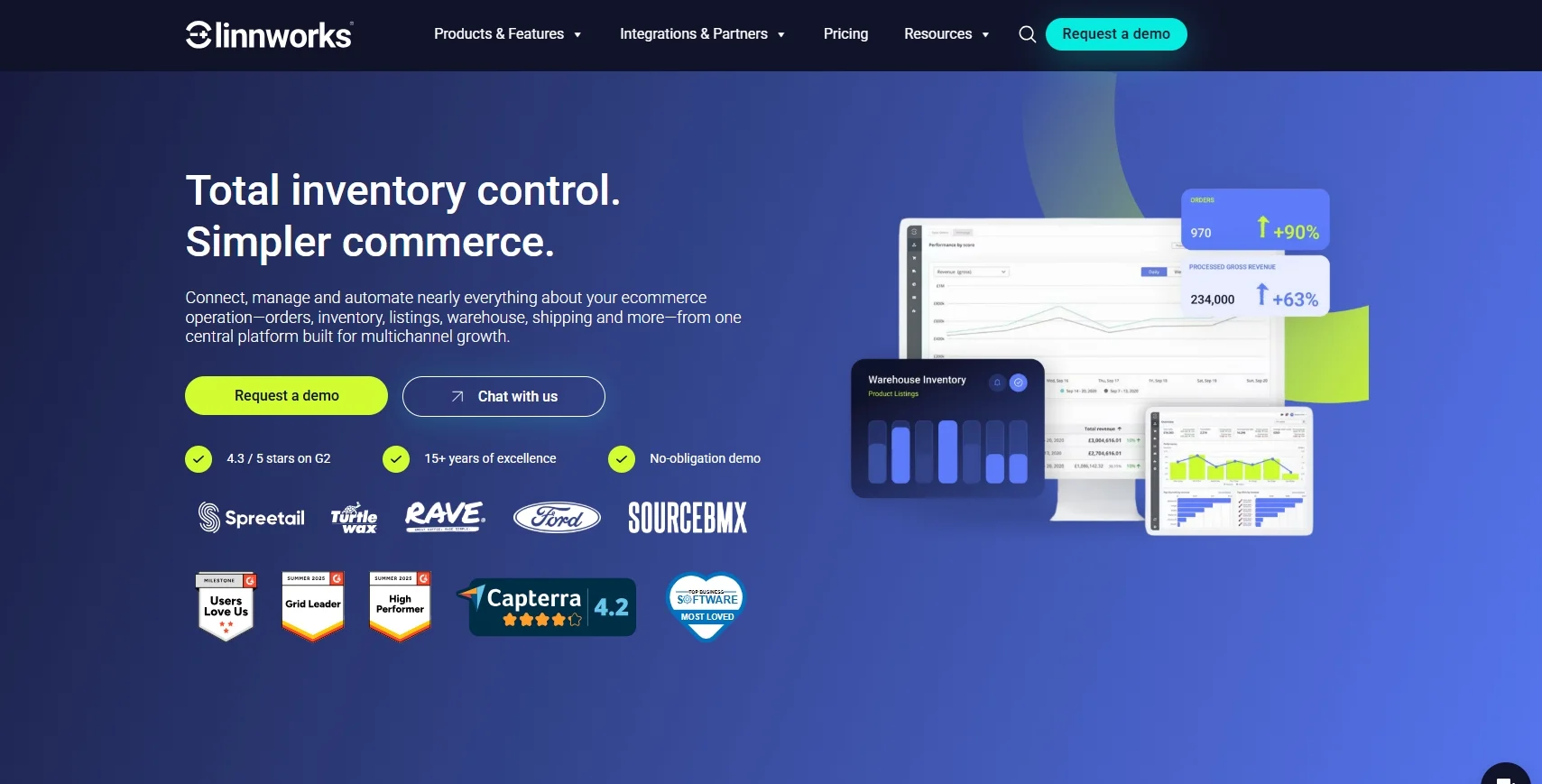
By connecting Linnworks to your store, you can take your BigCommerce inventory management to the next level. It automates stock syncing, streamlines order processing, and helps you maintain full visibility of your inventory across every channel you sell on.
Key features that Linnworks offers:
- Centralized inventory management for multichannel selling
- Real-time stock syncing between BigCommerce and other platforms
- Bulk listing and inventory updates across marketplaces
- Multi-warehouse tracking and routing rules
- Custom reports and inventory performance dashboards
Pricing: Depends on the number of orders you processed
#4. Pulse Commerce
Pulse Commerce is a cloud-based inventory and order management platform built to support mid-sized and enterprise-level merchants. When integrated with BigCommerce, it provides merchants with centralized control over inventory, orders, and fulfillment across all channels and locations.
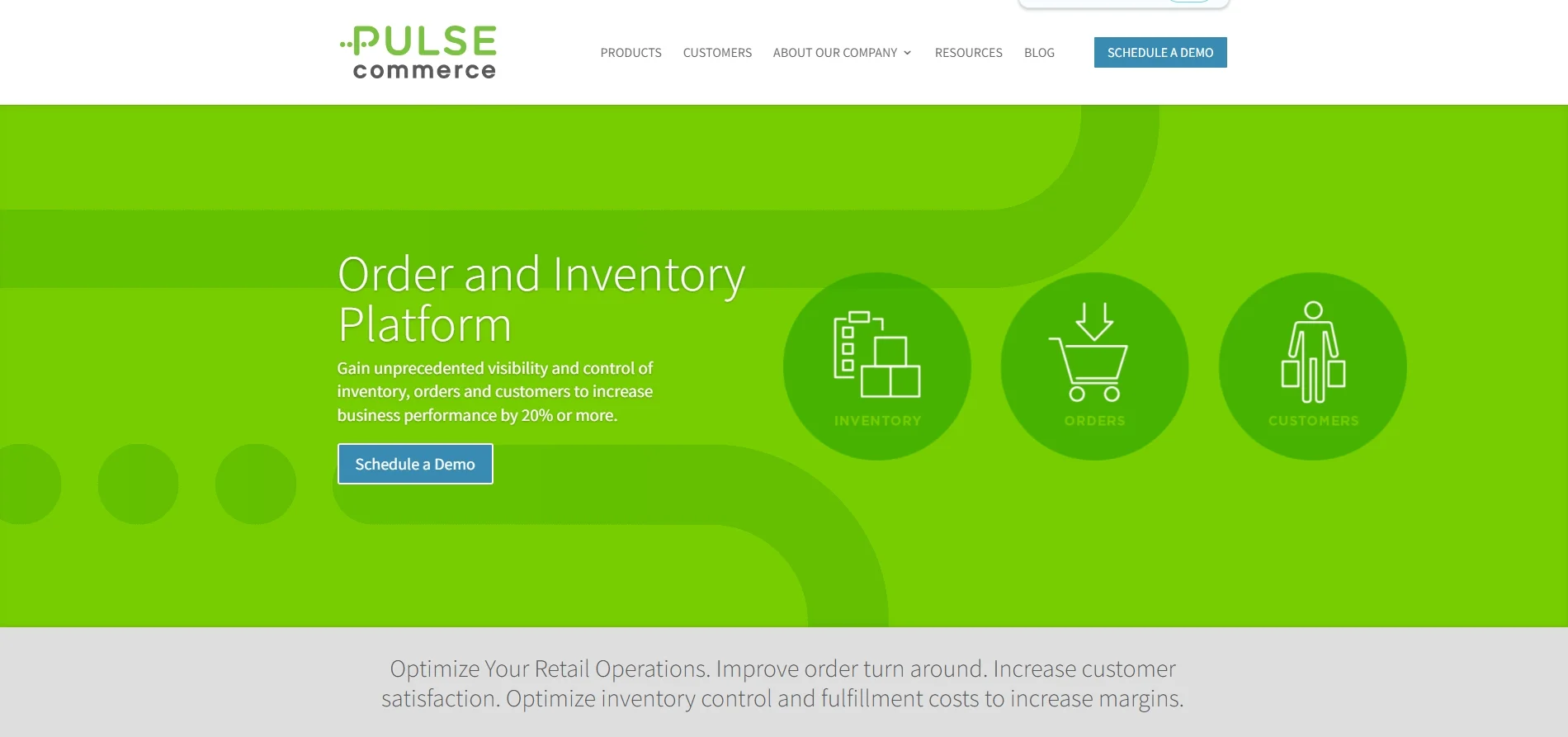
Pulse Commerce strengthens BigCommerce inventory management by giving users real-time visibility into stock levels, helping them make informed decisions and maintain inventory accuracy throughout their supply chain. It’s especially valuable for businesses with complex operations or those needing robust B2B and B2C order management.
Key features that Pulse Commerce offers:
- Real-time inventory syncing with BigCommerce and other channels
- Advanced order and fulfillment management tools
- Inventory forecasting and demand planning
- Role-based dashboards for team collaboration
- Integration with ERP, WMS, and shipping carriers
Pricing: Depends on your business size
#5 Brightpearl
Brightpearl is a retail-focused operations platform that combines inventory management, order processing, accounting, CRM, and reporting into one unified system. Tailored for omnichannel retailers, Brightpearl integrates smoothly with BigCommerce, giving merchants full control over back-office operations from a single platform.

With its real-time automation and intelligent workflows, Brightpearl enhances BigCommerce inventory management by removing manual tasks and ensuring accurate stock data across all sales and fulfillment channels. It is ideal for fast-growing businesses that need scalable infrastructure to support high order volumes and complex supply chains.
Key features that Brightpearl offers:
- Centralized management of orders, stock, and customers
- Multi-location and multi-warehouse inventory tracking
- Integrated accounting and financial reporting tools
- Demand forecasting and automated purchasing
- Native BigCommerce integration with fast syncing and automation
Pricing: Flexible
Best Practices to Manage Inventory in BigCommerce
An efficient BigCommerce inventory management requires a clear plan and consistent routines. Following the right practices helps you maintain accurate stock records, avoid common mistakes, and keep your operations running smoothly. Here are some recommended approaches:
1. Organize your product catalog from the start
To begin with, it is very important to build a clear and structured product catalog before you start selling. This means assigning unique SKUs, writing descriptive product names, and categorizing your products in a way that makes sense both to you and your customers. When your catalog is well-organized from the start, it becomes much easier to find, update, and track items as your store grows over time.
2. Turn on stock tracking for every product
Once your catalog is ready, it is essential to enable stock tracking for every product and variant you have in your store. When you turn on BigCommerce’s stock tracking feature, the platform automatically adjusts inventory levels whenever a sale is made, whether that order comes from your website or from another connected sales channel. As a result, you do not have to manually update stock levels after each purchase, which significantly reduces human error and saves valuable time.
3. Use bulk editing for large updates
If your store has a large catalog with hundreds or even thousands of products, updating inventory manually can become extremely time-consuming and prone to mistakes. To solve this, BigCommerce allows you to use bulk import and export tools to manage inventory more efficiently. In addition, bulk editing is useful for making pricing adjustments, updating product details, or changing tracking settings across multiple items.
4. Connect all your sales channels
When you integrate your sales channels, the system automatically updates stock levels in real time whenever a sale is made on any platform. As a result, customers always see accurate stock information, no matter where they shop. Additionally, connecting all channels reduces the risk of overselling because BigCommerce keeps all listings updated, which saves you from handling frustrated customers and unnecessary refunds.
5. Activate low-stock and out-of-stock alerts
Another key step is setting up low-stock and out-of-stock alerts for your products. By configuring these notifications, you get an early warning whenever a product is running low, which gives you enough time to reorder before completely running out. In addition, you can enable out-of-stock messages for customers so they know when an item is temporarily unavailable. When these alerts are in place, you can avoid sudden stockouts that might cause missed sales opportunities.
6. Analyze sales trends before restocking
Before placing new stock orders, it is wise to carefully analyze your sales history and look for patterns in customer demand. By understanding these trends, you can make smarter restocking decisions, ensuring you always have enough of the right products without overstocking slow sellers. Additionally, analyzing trends helps you plan ahead for promotions or busy periods, which can improve your inventory turnover and cash flow.
7. Regularly verify your inventory
Even when you rely on BigCommerce’s automatic tracking, it is still important to physically check your inventory on a regular basis. Scheduling inventory audits or cycle counts helps you confirm that your digital records match the actual stock in your warehouse or storage area. This practice helps you identify slow-moving products, which can guide your future purchasing and stocking decisions.
8. Consider advanced tools as you grow
Finally, as your business grows and your operations become more complex, you may reach a point where BigCommerce’s native features are no longer enough to handle your inventory needs. When that happens, consider integrating advanced inventory management software that offers features such as demand forecasting, automated purchase orders, supplier tracking, and warehouse management. These tools can streamline complex workflows and give you more detailed control over your entire supply chain.
BigCommerce Inventory Management – FAQs
Does BigCommerce have an inventory management system?
Yes, it does. BigCommerce includes a built-in inventory management system. It allows you to track stock levels for each product and variant, set low-stock alerts, and update inventory manually or in bulk using CSV files. You can also enable automatic stock tracking so that inventory levels update in real time whenever a sale is made.
While these native tools work well for basic needs, many merchants integrate third-party software to handle more advanced inventory tasks like multi-warehouse tracking, forecasting, and automation.
How to manage inventory for BigCommerce?
To manage inventory in BigCommerce, start by enabling inventory tracking for each product. You can add or update product quantities manually through the admin panel or import updates in bulk using a CSV file. You can also set up low-stock warnings and configure your store’s behavior when items go out of stock (e.g., hide product, allow backorders).
For businesses selling on multiple channels or managing large catalogs, connecting an inventory management app or using BigCommerce’s API allows for more automated and scalable workflows.
What is the best inventory management software for BigCommerce?
The best inventory management software for BigCommerce depends on your business size and needs. Some top options include:
- ConnectPOS: Ideal for syncing in-store and online sales
- Extensiv (formerly Skubana): Best for high-volumn, multichannel sellers
- Linnworks: Great for managing inventory across many platforms
- Pulse Commerce: Suited for complex fulfillment and enterprise operations
- Brightpearl: An all-in-one solution that combines inventory, orders, and accounting.
What are the four types of inventory?
The four main types of inventory are:
1. Raw materials: Items used to produce finished products (eg., fabric, metal parts)
2. Work-in-progress (WIP): Products currently being assembled or manufactured
3. Finished goods: Completed products ready for sale to customers
4. Maintenance, repair, and operations (MRO) inventory: Supplies used to support production or daily operations (e.g., tools, cleaning supplies)
Final Words
And that's the end of our BigCommerce inventory management guide. Now that you've explored the options, features, and strategies, you’re well-equipped to take full control of your BigCommerce inventory and optimize it for long-term success.
Lastly, if you like this article, don't forget to check out other blogs on our LitExtension website for more expert tips and insights.


